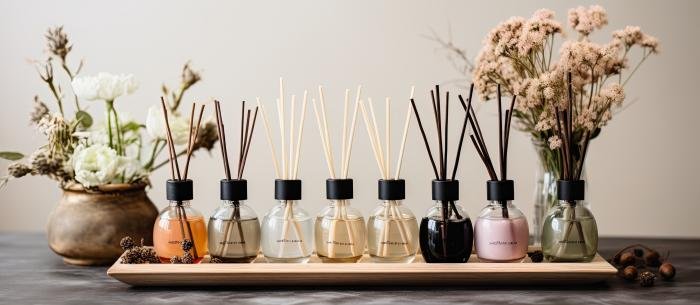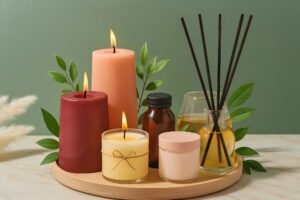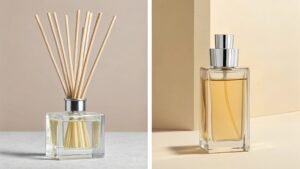Choosing the wrong scented fragrance oils for home can leave your living spaces feeling flat and unwelcoming, missing the transformative power of perfect ambiance.
The best scented fragrance oils for home combine quality ingredients, appropriate scent strength, and seasonal versatility. Consider room function, oil concentration, and diffusion methods when selecting home fragrance options that create lasting, appealing atmospheres throughout your living spaces.

As homeowners increasingly seek alternatives to traditional candles, scent oils offer safer, longer-lasting solutions for enhancing home ambiance without open flames or smoke concerns.
What’s the Difference Between Essential and Fragrance Oils?
Struggling to choose between essential vs fragrance oil for your home? Both promise beautiful scents but deliver vastly different experiences.
Essential oils are natural plant extracts, while fragrance oils are synthetic blends designed to mimic scents. Essential oils offer therapeutic benefits; fragrance oils provide consistent, long-lasting aromas at lower costs.

Natural Origins vs Synthetic Creation
Essential oils come from steam distillation, cold pressing, or extraction of flowers, leaves, bark, and roots. These natural oils retain the plant’s therapeutic properties and chemical complexity. Lavender essential oil, for example, contains over 100 naturally occurring compounds that work together synergistically.
Fragrance oils are laboratory-created blends of synthetic aromatic compounds. They’re designed to replicate natural scents or create entirely new fragrance profiles. While they lack therapeutic benefits, synthetic fragrance offers remarkable consistency and scent longevity that natural oils often cannot match.
Cost and Performance Comparison
Price per ml varies significantly between these oil types. Essential oils typically cost $15-50 per 10ml bottle, while fragrance oils range from $5-15 for the same size. However, fragrance oils often require fewer drops to achieve the same scent intensity.
| Caraterística | Óleos essenciais | Fragrance Oils |
|---|---|---|
| Average Cost (per 10ml) | $15-50 | $5-15 |
| Longevidade do aroma | 2-4 horas | 6-12 hours |
| Drop Usage | 8-15 drops | 3-8 drops |
| Non-toxic Rating | Generally yes | Varies by brand |
| Opções de embalagem | Dropper bottles standard | Multiple formats available |
When selecting oils for everyday use, consider your priorities: natural origins and potential wellness benefits favor essential oils, while consistent performance and budget-friendly pricing lean toward quality fragrance oils with non-toxic formulations.
How Do You Choose the Right Scent Profile for Each Room?
Struggling to create the perfect ambiance in your home? Wrong room scent oils can clash with activities and moods, creating an unpleasant atmosphere that affects your daily comfort.
Choose room scent oils based on function: energizing citrus scents for kitchens, calming lavender for bedrooms, and fresh eucalyptus for bathrooms. Consider room size and natural airflow when determining fragrance by room and scent strength.

Understanding Scent Families by Function
Different rooms serve unique purposes, making fragrance by room selection crucial for optimal experiences. Kitchens benefit from clean, fresh scents like lemon or mint that neutralize cooking odors without competing with food aromas. Living room diffuser oils should create welcoming atmospheres—vanilla, sandalwood, or gentle florals work well for entertaining spaces.
Bedrooms require relaxing profiles such as lavender, chamomile, or soft vanilla to promote restful sleep. Bathrooms need refreshing scents like eucalyptus, tea tree, or citrus blends that feel clean and invigorating. Work areas benefit from focus-enhancing scents like peppermint or rosemary.
Mastering Scent Strength and Layering Techniques
Home fragrance layering involves balancing multiple scent sources without overwhelming the space. Start with subtle base notes through diffusers, then add complementary room sprays for occasional intensity boosts. Consider room size when determining scent strength—larger spaces need stronger concentrations or multiple diffusion points.
| Tipo de quarto | Recommended Scent Strength | Best Fragrance Families | Layering Approach |
|---|---|---|---|
| Sala de estar | Médio | Vanilla, Sandalwood, Citrus | Base diffuser + accent candles |
| Quarto de dormir | Leve-Médio | Lavender, Chamomile, Soft florals | Single diffuser, low intensity |
| Kitchen | Light | Lemon, Mint, Clean linens | Quick-dispersing sprays |
| Casa de banho | Medium-Strong | Eucalyptus, Tea tree, Fresh citrus | Concentrated oils, good ventilation |
Quality dropper bottles and leak-proof packaging ensure your room scent oils maintain potency while offering flexible size options for different spaces and budgets.
Which Seasonal Scents Can Transform Your Home Throughout the Year?
Choosing the wrong seasonal home fragrances leaves rooms feeling disconnected from nature’s rhythm. Mismatched scents create awkward atmospheres. Strategic seasonal scent selection transforms living spaces into harmonious environments.
The right seasonal home fragrances include light florals for spring, fresh citrus for summer scents, warm spices for fall, and rich pine for winter fragrance oils. Each season requires distinct scent profiles that complement natural temperature and mood changes.

Spring and Summer Fragrance Transformations
Spring calls for renewal through light, airy seasonal home fragrances. Jasmine, lilac, and fresh grass notes awaken homes from winter dormancy. These delicate scents pair perfectly with open windows and increased natural light.
Summer scents demand cooling relief through citrus-forward profiles. Lemon, grapefruit, and ocean breeze notes create refreshing atmospheres during hot months. These energizing fragrances complement outdoor entertaining and casual living.
Fall and Winter Scent Transitions
Fall marks the shift to comforting holiday scent oils featuring cinnamon, apple, and amber. These warming notes prepare homes for cozy gatherings and longer evenings indoors. Pumpkin spice and vanilla create welcoming atmospheres for guests.
Winter fragrance oils embrace rich, woody profiles that combat seasonal blues. Pine, cedar, and peppermint evoke holiday traditions while maintaining sophistication. These robust scents provide psychological warmth during cold months.
| Época | Primary Notes | Mood Impact | Best Locations |
|---|---|---|---|
| primavera | Floral, Fresh | Energizar | Living rooms, bedrooms |
| verão | Citrinos, Marinha | Cooling | Kitchens, bathrooms |
| outono | Spice, Fruit | Comforting | Dining rooms, entryways |
| inverno | Wood, Pine | Warming | Family rooms, studies |
Strategic seasonal transitions require gradual scent layering rather than abrupt changes. Quality fragrance oils in leak-proof dropper bottles ensure consistent scent distribution while protecting your investment in premium seasonal home fragrances.
What Are the Best Methods to Diffuse Scented Oils in Your Home?
Choosing the wrong oil diffusion method can leave rooms unscented or overwhelm spaces with fragrance. Poor diffuser placement wastes expensive oils and creates uneven scent distribution.
The best home diffuser oils methods include reed diffusers for continuous passive scenting, ultrasonic diffusers for controlled intensity, and nebulizing diffusers for maximum scent throw without dilution.

Reed Diffusers: Simple and Continuous
Reed diffusers offer the most straightforward approach to oil diffusion methods. These systems use natural fiber reeds to draw fragrance oils up through capillary action, releasing scent consistently without electricity. They work best in smaller spaces up to 150 square feet and provide 4-8 weeks of continuous fragrance depending on oil concentration and room conditions.
The key advantage lies in their passive operation—no maintenance, timers, or power requirements. However, scent throw remains limited compared to active diffusion systems. Quality reed diffusers require leak-proof packaging and dropper bottles for easy refilling, making size options crucial for different room requirements.
Ultrasonic vs. Nebulizing: Active Diffusion Comparison
Active diffusers provide superior scent throw and coverage control. The choice between ultrasonic and nebulizing systems depends on your specific needs and oil types.
| Diffusion Method | Área de cobertura | Oil Usage | Intensidade do aroma | Melhor para |
|---|---|---|---|---|
| Difusores de cana | 50-150 sq ft | Baixa | Mild-Medium | Small spaces, continuous use |
| Ultrassónico | 200-500 sq ft | Médio | Médio-Alto | Living areas, adjustable timing |
| Nebulização | 300-800 sq ft | Elevado | Maximum | Large spaces, pure oil experience |
Ultrasonic diffusers use water to create a fine mist, making oils last longer while providing humidity benefits. Nebulizing diffusers atomize pure oils directly, delivering the strongest scent throw but consuming oils faster. For optimal results, place diffusers in central, high-traffic areas away from windows and direct sunlight to maximize fragrance distribution and longevity.
How Can You Identify Quality Fragrance Oils That Last Longer?
Struggling to find fragrance oils that maintain their scent throughout the day? Poor quality oils fade quickly, leaving you disappointed and constantly reapplying.
Quality fragrance oils with higher oil concentrations (8-12%) and proper molecular composition provide superior longevity. Look for pure ingredients, proper packaging, and concentration details on labels.

Oil Concentration and Formula Composition
The primary indicator of quality fragrance oils lies in their concentration levels. Premium oils typically contain 8-12% fragrance load, which ensures optimal scent throw and longevity. Higher concentrations don’t always mean better performance – the molecular composition matters more. Quality oils use base notes like sandalwood or vanilla that evaporate slowly, creating lasting power.
Essential oil blends often outperform synthetic alternatives in longevity tests. Pure ingredients bond differently with surfaces, releasing fragrance gradually over time. When evaluating oils, check for transparency in ingredient listing and avoid products with excessive fillers or alcohol content.
Physical Quality Indicators and Packaging Standards
Professional-grade fragrance oils exhibit consistent viscosity and clear appearance without cloudiness or separation. Quality suppliers provide detailed concentration information and batch testing certificates. Proper packaging in amber glass dropper bottles protects oils from light degradation and ensures leak-proof storage.
| Fator de qualidade | Premium Grade | Standard Grade | Poor Quality |
|---|---|---|---|
| Oil Concentration | 8-12% | 4-7% | Under 4% |
| Duração do perfume | 6-8 horas | 3-4 hours | 1-2 horas |
| Embalagem | Glass dropper | Plastic bottle | Basic container |
| Price per ML | $0.80-1.20 | $0.40-0.70 | Under $0.40 |
Size options matter for both testing and value. Quality suppliers offer sample sizes for evaluation before committing to larger volumes, ensuring you find the perfect long-lasting scents for your space.
Conclusão
Creating the perfect home atmosphere with scented fragrance oils requires understanding the differences between essential and synthetic options, matching scent profiles to room functions, embracing seasonal transitions, choosing appropriate diffusion methods, and investing in quality oils with proper concentration levels. The best scented oils for home diffuser use combine these elements to transform your living spaces into personalized sanctuaries that reflect your style and enhance daily experiences throughout the year.
FAQ
Q1: What is the difference between essential oils and fragrance oils for home use?
Essential oils are natural extracts from plants, offering therapeutic benefits, while fragrance oils are synthetic or blended scents designed for stronger, longer-lasting aromas. Fragrance oils are ideal for home use due to their variety and scent strength.
Q2: Are scented fragrance oils for home non-toxic?
Many scented fragrance oils are non-toxic, but it’s important to check labels for certifications like IFRA or FDA approval. Opt for brands that disclose ingredients and prioritize safety, especially for households with pets or children.
Q3: How do I choose the right scent strength for my home?
For subtle aromas, opt for lighter scents like citrus or floral oils. For stronger, long-lasting fragrances, choose deeper notes like vanilla or sandalwood. Consider room size and ventilation when selecting scent strength.
Q4: What are the best seasonal scents for home fragrance oils?
Spring and summer pair well with fresh, floral, or citrus scents like lavender or lemon. Fall and winter call for warm, spicy, or woody aromas such as cinnamon or cedarwood to create a cozy atmosphere.
Q5: What packaging options are available for home fragrance oils?
Home fragrance oils often come in dropper bottles for precise application or leak-proof containers for safety. Size options range from small trial sizes to bulk bottles for frequent users.




